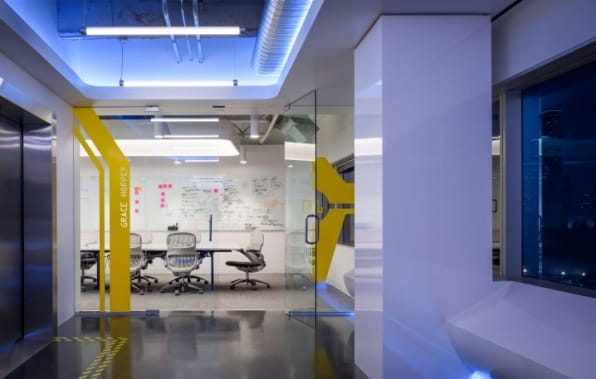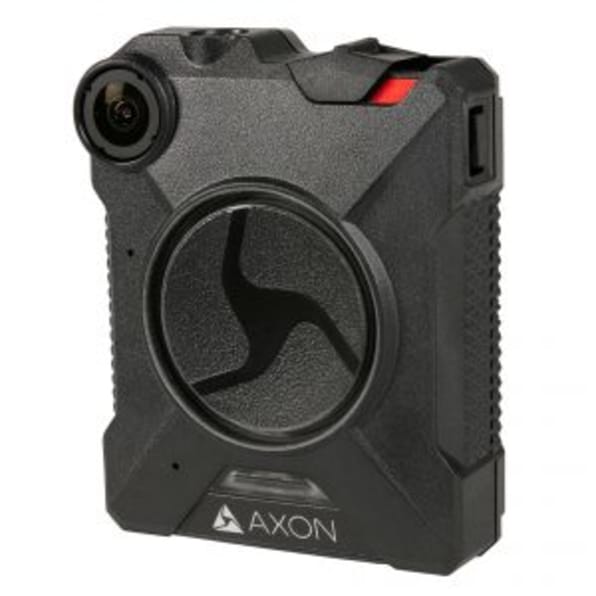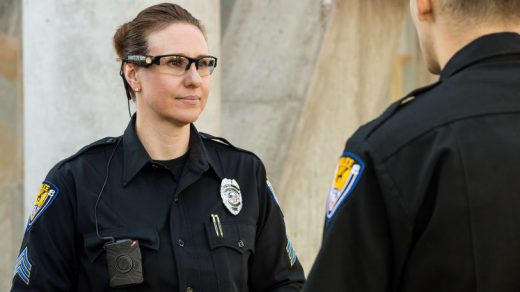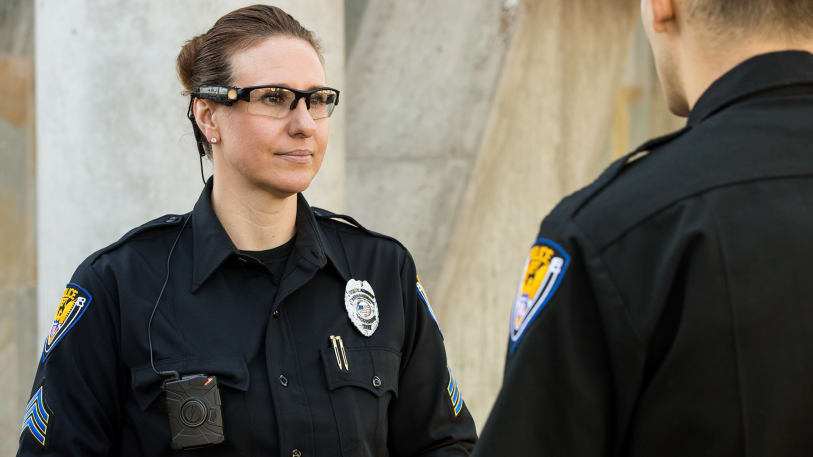Why Taser Changed Its Name And Offered Every Cop A Body Camera
Taser, the company known for its eponymous electric stun guns, announced on Wednesday it would change its name to Axon as part of its aggressive push to dominate the burgeoning market for body cameras–and the lucrative video and data services those cameras require.
It also announced an initiative to solidify its strong lead over the competition while the market is still young: It will offer body cameras and cloud storage free of charge for a year to any eligible police department in America.
“We don’t see any reason why you should send a police officer on the street with a gun and no body camera,” says Rick Smith, the company’s founder and CEO.
The name change, years in the making, was prompted by the company’s determination to focus on technology, and distinguish it from the stun gun for which it is widely and controversially known. “We have 95% brand awareness,” says Smith, but “Taser is very strongly associated with the electronic weapon.” Though the gun generally gets high marks from law enforcement, it has generated plenty of controversy since many people shot by the “less-lethal” weapon have died or been severely injured.

“We’ve seen the need to do this” for a few years, says Smith, referring to the name change. Since Ferguson incited new public demand for more trust and transparency in policing, Taser has become the leader in police body camera sales. The Scottsdale, Ariz.-based company, which already has a virtual monopoly in electrical weapons, still sells more Tasers than cameras. But last year, for the first time, it saw its future bookings for its Axon cameras surpass those of its electric weapons. (Axon is the name of its younger Seattle-based technology division; the Taser name will survive as the weapons brand.)
Already, Axon says its cameras have been deployed in 36 out of 69 major U.S. cities, and that police have collectively stored more than seven petabytes of data on Evidence.com, its cloud-based video storage and management service, with 90 videos uploaded every minute.
The “free trial” program—an idea more common to consumer services like Spotify and Netflix than government procurement—aims to give officers across the country year-long access to an Axon Body 2 camera; specialized training; and a storage subscription on Evidence.com. Based on list prices, Smith estimates the trial will be worth about $ 1,700 a year per officer.
But it won’t be completely free: Body cameras involve additional costs for administration and staff to help manage the torrents of footage they generate. In Baltimore county, for instance, where police are paying $ 12 million for about 1,400 cameras and eight years of storage, annual operating costs for managing the footage are estimated at $ 1.6 million. But even with those kinds of costs, Smith believes agencies “will save much more over time” by documenting police encounters on video.
While agencies will be allowed to keep their footage after the free trial, Axon is betting they’ll become loyal customers and subscribers. “We’re taking a pretty big financial risk,” says Smith, but “we looked at this and we frankly feel that the benefits are so overwhelming. If we can get cameras in the hands of police officers, they will immediately pay for themselves.”
In 2016, when Axon earned over $ 268 million, it reported that weapons revenue was up 25% over the year before, while video revenue jumped 152%. Glenn Mattson, an analyst at Ladenburg Thalmann, expects that sometime in the next year, revenues from subscriptions to Axon’s video storage service will overtake revenues from the cameras themselves.
Axon’s offer is also likely to draw more scrutiny to its sometimes dubious efforts to win police contracts. Other companies have accused it of trying to muscle out the competition by building cozy relationships with cops, waging aggressive lobbying campaigns, and using allegedly unfair tactics. After two recent failed bids, in New York and Phoenix, the company was accused of unfairly trying to influence those police departments with offers of “free” cameras.
Vievu, a smaller competitor owned by the police supplier Safariland, said in a statement that the free camera effort was a publicity stunt that “is at best unethical and at worst illegal.” It warned that such an offer comes with other heavy internal costs and that using the software for a year will effectively force police to commit to Axon’s services, “or face exorbitant switching costs.”
John Collins, a Vievu spokesperson, said the offer is “analogous to asking someone to get a free tattoo on his or her face—you’d better be sure you want it because it is very difficult to get rid of it once you do.”
Smith has dismissed some of the allegations against Axon as “a little bit of noise that comes with being a market leader,” but says that to avoid conflicts, it will not offer free cameras to law enforcement agencies with whom it’s already pursuing business.

“Accelerate The Market”
The fierce competition underscores the national rush to adopt body cameras in the wake of a series of high-profile deaths, many of unarmed black men, at the hands of police. Bolstered by over $ 60 million in Justice Department grants during the Obama administration, the push has been called by some police experts the fastest upgrade in policing tech they’d ever seen. Cameras can help de-escalate some encounters between cops and members of the public, some studies have shown, and in some cases officers wearing body cameras may be less likely to use force. Body camera footage might also help defuse citizen anger after a deadly incident involving a cop if police departments make available to the public the video recording of what happened.
But today, Smith says, “only 20% of officers are wearing cameras.” That rough estimate, from a survey of police agencies last year, showed a gap between familiarity with the devices and their actual use: Half of the country’s police departments had either started or completed tests of body cameras, but still haven’t deployed them. “Literally every chief or sheriff you talk to, or doing media interviews, one question that commonly comes up is, why is that so many agencies aren’t deploying?” he says.
A number of cities that initially rushed to cameras have been ensnared in tricky policy and fiscal questions: When should they be recording? Who gets to see the footage? Who will pay for the cameras and the data storage and staff they require? Meanwhile, funding may be scarcer. The Trump administration has indicated it’s not as committed to supporting local efforts at police reform, and may withhold federal police funding from so-called “sanctuary cities.”
In any case, argues Smith, waiting for federal money “can actually slow the transition” to body cameras in cities. “What we’re trying to do is accelerate the market forward.” His message to police agencies is, “‘We think these things are useful; we think you will as well. Let’s not wait to see if there’s federal funding or not.’”

The Network Effect
Founded in 1993 by Smith and his brother Thomas in their garage with the mission “to make bullets obsolete,” Axon is still smaller than a few of its would-be competitors in the body camera industry. Motorola, Panasonic, and Vievu, are, along with smaller makers like Digital Ally and Utility, angling for part of what is estimated to be a $ 1 billion market. At a glance, their cameras can seem mostly indistinguishable—most boast enough battery life to last an officer’s shift—but they can vary widely in price, features, and back-end software.
Axon’s pitch to police departments is often more high-tech than the typical argument made for cameras—that they help improve transparency and trust between police and communities. Instead, Smith’s company sells the cameras and Evidence.com as part of a complete package aimed at storing and managing police data—devices and platforms—in a way that mirrors Apple’s products and operating system.
The devices capture video—from body cameras, dash cameras, and interrogation rooms—while the platform provides secure storage and management, using the Amazon and Microsoft clouds. The subscription-based Evidence.com software helps officers share clips with prosecutors and assists in automatically redacting names and blurring out faces, so they can be more quickly shared with the public.
Eventually, Smith says, the software will help automatically analyze the video for more immediately useful and actionable data, integrating with legacy systems for records management, and saving time and money for police. Combining body camera video with artificial intelligence could also automate other parts of police work, for instance, by capturing license plate numbers and faces in order to find criminals.
Eyeing that future, the company has been on a tech hiring spree, recently recruiting senior executives from Tesla, GoPro, and Apple—including Todd Basche, who helped build the iLife suite of software that contains iTunes and iMovie—and acquiring a machine learning startup, Dextro, in order to build a new unit, Axon AI.
The name Axon—”the extension of your nerve cells that reaches out, carrying information to the others,” explains Smith—describes his vision for cameras, as sensors connected to a larger network. But it’s also a self-fulfilling prophesy, better for attracting computer scientists than a brand that’s associated with weapons. (The Taser’s inventor, a NASA researcher named Jack Conway, named it after a 1950s children’s book, Tom Swift and His Electric Rifle.)
Hadi Partovi, the founder of the nonprofit Code.org and a member of Axon’s board, said the brainy name would help continue the company’s internal transformation. “With the new name Axon, I believe we’re going to have an even easier time recruiting top tech talent,” he said.
What’s In A Name?
Axon has benefited from its longstanding relationships with police, and a solid reputation among cops. For Partovi, one of the biggest surprises was “how much police, frankly, love the company,” he says. It’s a company that they know “has their back, and is building products for them.”
Outside of policing, however, Axon has weathered many lawsuits and waves of negative attention. As the company’s Taser stun guns took off in the early 2000s, it also began to face dozens of lawsuits over injuries and deaths. (In 2012, Amnesty International said that the number of people who have died after being struck by a Taser had reached more than 500.) The company prevailed in most of its legal cases, but in 2009 it revised its safety warnings to say that exposure of the electrical weapon to a person’s chest risked causing cardiac arrest.
Stemming what it called false accusations about its products and defending the company and its police customers was one of the reasons Taser began to focus on video evidence to begin with. When the company launched Evidence.com in 2009, then-chairman Tom Smith said that police video could slice Taser’s own legal costs in half.
The body camera business, with its clear links to concerns about public trust and transparency, called for a fresh identity, and one that the public can relate to. For companies like Taser, with their close police relationships, that can be difficult.
“These are companies whose business is something very connected to the public interest,” said Barry Friedman, a constitutional lawyer and the director of the Policing Project. “But they have a conception of public safety that’s been developed over a long period of time with law enforcement. Plenty of folks that work in these companies come from law enforcement. And I’d like to think that all of them can be good public citizens if engaged in a conversation with the public, but it’s just not happened.”
Hadi Partovi, who was also an early advisor and investor in companies like Facebook and Dropbox, sees Axon as a broader, more public-facing tech brand, part of a shift he’s been pushing for since he joined the Taser board in 2010. It was with his guidance in 2013 that Taser paid $ 3 million for Familiar, a photo-sharing app startup he’d invested in, in order to bolster its existing Evidence.com software. The result was a new unit called Axon and a high-tech office in Seattle. “As soon as the company embarked on this new business, I remember having the conversation that this is a much larger opportunity, and if we succeed at it, the name of the company is going to need to be reinvented—the entire business is going to reinvent the company.”

With its police customers, says Smith, the old name was complicating the company’s effort to shape itself as a force in police video and data. “One of the analogies we’ve used within the company: imagine we were Harley Davidson–and we said, ‘we’re here to talk about software.’”
The decision to become Axon became clear once future body camera bookings overtook projected revenues from Tasers, says Partovi. “That was a long time coming, a really important milestone. To be able to start a new business, especially a new business in a completely different road—it would be as if Facebook started something new, and then that new thing became bigger than Facebook itself.”
Facing The Public
Despite the new identity, Axon still faces a wave of questions and concerns about its business practices. Competitors have accused the company of maintaining an unfair edge by coaching departments on how to use so-called no-bid contracts or arrangements in which agencies piggyback off existing stun-gun or body camera contracts at other departments, or by offering trials of free cameras.
In February, Taser was reprimanded by the attorney for the city of Phoenix for offering “free” cameras to the police, after it had lost to Vievu in a bid for the city’s body camera contract. In a lawsuit, Vievu charged Taser with interfering with the contract, which the city ultimately scuttled in favor of a new request for proposals.
That same month in New York City, where the company lost a body camera contract to Vievu after a bitter lobbying battle, the mayor accused then-Taser of waging a “smear” campaign against its competitor. There too, the company was accused of making an unfair offer of “free” cameras after it had lost the bid. A company spokesperson said that the company had made a similar offer in January to all major law enforcement agencies.
For Smith, the debacle was “a wake-up call” to problems with the way that police buy technology, he says. “These are rules that need to be broken and thrown away.” The procurement processes, “decade old procedures to buy boots, belts, shoes,” he says, are the opposite of Agile, the iterative approach to software development. “You need to get it in the hands of users. You can’t just buy it in the old fashioned way,” he says.

The “move fast and break things” approach may mean faster roll-outs of cameras and quicker business for Taser, but that could also stymie fair competition, create an appearance of impropriety, and lead to other problems down the road.
“From a business perspective, Taser might be very smart, very strategic” to offer free cameras, said Mike Purdy, a public procurement and contracting consultant in Seattle. “But when we talk about public procurement the concept is to be fair, open, and transparent. And we don’t want to give preference to one company over the other. Otherwise, that ends up being unfair competition.”
It’s up to local governments to develop purchasing processes that are open and at least allow competitors to offer trials as well. “Governments may want to take quick action,” he said, “but in doing so you might skirt some of the appropriate mechanisms.”
Rushing into technology contracts without fair and public consideration can mean getting the wrong technology, or being locked in to proprietary systems that are hard to uninstall, Purdy said. A too-speedy process—or impressions of unfair advantages—can spark accusations, lawsuits, or investigations into a purchase, all of which can actually lead to delays in rolling out new technologies.
In some cities, including Atlanta and Austin, investigations into bids by Taser have delayed the roll-out of cameras. In Orlando, the city delayed a purchase of cameras last year after it emerged that a police official in charge of the program was also being paid by Taser to help train police at other agencies using cameras. (The city went with Motorola body cameras instead, at a cost of $ 1.1 million for 450 cameras—versus a $ 600,000 bid from Taser—and about $ 800,000 a year to store the data.)
Civil rights advocates also warn that deploying cameras too quickly can lead to uses and policies that are adverse to the public. “There’s definitely a move to do this quickly,” said Purdy. “But we have to remember that anytime we’re doing technology and especially emerging technology, it’s a complicated area.”
Smith, whose products have weathered storms of controversy for over a decade, isn’t fazed by the questions that surround his company’s business practices. Axon’s contracts have been won on the basis of quality alone, he says, noting the high scores its cameras receive in field trials. “Playing unfairly to win deals, that gets too much credence. With many big cities, going through field trials, we’ve been selected hands down.”
But the new name and identity reflects a desire by the company to win the public’s trust, too.
“The transparency that the public expects of law enforcement is something we hope people can rely on Axon to deliver to them,” said Partovi. What that means is “people knowing that if a police officer is wearing an Axon camera, they can trust that their interactions are going to be recorded, and that those recordings are going to be treated with integrity, with privacy, without tampering, with security.”
He added: “I absolutely think that Axon is going to need to be a public-facing brand as well as a safety brand.”
(183)








